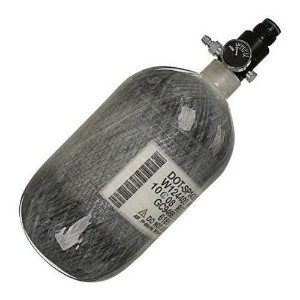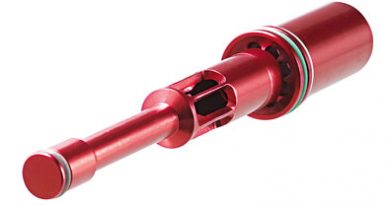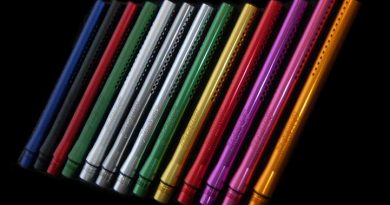Nitro or CO2?
By Andrew C. Syren
The one aspect of paintball that seems to be last on the new players mind is the type of propulsion they should buy along with that shiny new marker. I thought it best to give you, the reader, an opportunity to see the pros and cons of the two most common types of gas used in paintball; CO2 and HPA.
Both types of gas have some similarities that cannot be ignored but they are both so different, in so many ways, that one should understand them fully before making the decision on what gas they wish to use for their marker.
Since CO2 was the first propulsive gas used in paintball we will begin there. CO2 in its natural state is better described as a liquid rather than a gas. However, when liquid CO2 reaches a particular temperature, it transforms into a gas. This particular temperature is known as the “boiling point” for the liquid.
Understanding that CO2 requires a higher temperature than it’s boiling point to become a compressed gas within the tank or cylinder you may conclude that the outside temperature adversely affects the pressure that your CO2 creates.
Having tested this theory I have found that CO2 puts out an average of 850 pounds per square inch of pressure at a cozy room temperature of 70 degrees. This may sound pretty good however, at 60 degrees we find that CO2 creates a pressure of about 750 psi. For those that play in the Michigan climate, you might like to know that on a 40 degree November day your CO2 is only putting out a mere 550 psi.
The fluctuation in temperatures adversely affecting the output pressure of CO2 can be considered a con to most outdoor paintball players; especially if they are subjected to the colder climates. But to the average player in Southern California this would be no problem at all. Finding a shop that carries CO2 is not all that difficult either, as it has been used for so many other useful purposes including plant research and developments.
At the local paintball store in any given area, CO2 can be as cheap as 0.30 cents an ounce or for those who don’t feel like doing the math, 6 dollars for a 20 ounce tank. A CO2 tank can cost anywhere from 9 dollars to 29 dollars depending on the size and manufacturer. This is a pro to most new players as it helps them get out onto the field of play for much cheaper than the alternative.
The one important factor to look into when purchasing CO2, is the amount of shots you’re going get out of a full tank. This is where the con side of CO2 comes into play. As we stated previously, temperature affects the output pressure of CO2 greatly, thus causing an inconsistent reading for the amount of shots you’ll get for a full tank. At lower temperatures you may get fewer shots than you would out of a tank in higher temperature conditions.
Also, please understand, the ambient temperature is not the only thing affecting the number of shots from your tank, but the marker’s efficiency is a major factor as well. Since we are focused on the gas at this time we will not discuss efficiency at this time.
Although we are not going to delve deeply into efficiency, the marker itself can be a huge deciding factor on what gas you use. The markers of old were very basic in way of firing. These markers did not contain the electro-pneumatic internals as the markers of today. Small amounts of liquid CO2 that reached the internals did not harm the workings of the marker as much as it might with the newer style markers.
With the exception of a blown o-ring, the markers were capable of handling the rigors of liquid CO2 entering the markers itself. Today, the electro-pneumatic markers require that there be no liquid entering the internals of the marker. The liquid may cause the marker to malfunction.
Examples of markers that would not work with standard CO2 would be the Matrix, Angel, Intimidator and the Impulse. Markers that would have little to no effect due to liquid CO2 entering the markers internals would be the Tippmann line up of markers, the Kingman Spyder and the Autococker.
If you are determined to run CO2 with your marker and your marker is a marker that should not be using CO2, there is a simple solution. CO2 tanks can have what is called an anti-siphon tube installed into them to keep the liquid from ever exiting the tank and into your marker.
Obviously, not all paintball fields have adapted to the standards of these markers by making HPA available. So, some of us may still have to go with CO2. If it is the only gas you have available, then have the anti-siphon tube installed into your tank and you will notice a great difference in the output performance of your tank.
Now that we have an idea of what CO2 is and understand what the pros and cons, lets move onto the other gas used in paintball. High pressure air, or HPA for short, is becoming the most desired choice of gas used in paintball today.
With the growth of tournament play in the world, the use of HPA has nearly become a necessity. With its fast recharge rates and extreme consistency, HPA is the best choice for the player who can achieve the highest rate of fire with her paintball marker.
Consistency is the most desirable aspect of HPA. HPA can only be as consistent as the bottle is regulated. And the regulation of this gas can become very expensive. The first con to HPA is just that. The expense of it can be overwhelming to any newer player who does not fully understand the benefits in using HPA.
New bottles range from 70 to 500 dollars. With the varying weight and consistency of each bottle type being the factors in which pricing is made. Consider that these bottles can become as high-tech as any high-end marker such as the Intimidator or the Angel. Making the choice in which bottle is for you is a decision only you can make, for the sake of simplicity lets stick with a standard preset screw in tank that would resemble the before mentioned CO2 tanks.
A standard steel 47 cubic inch HPA tank with a tank pressure of 3000psi would run about 70 to 80 dollars. Compared to the 20 ounce CO2 tank that would cost about 30 dollars this would seem to be a bit steep. However, considering the pros of HPA one might justify the purchase of the HPA system over the CO2 tank.
HPA is, and will always be, the most consistent choice of gas to use for paintball. Why is this? Simple, it is unaffected by the temperature or climate, thus creating a better shot to shot consistency. With better consistency, you will find that your accuracy is better over all. With the output pressure of your tank ranging from 600 psi to 750 psi your markers velocity will suffer and the accuracy of your marker will follow suit.
If you have a rather fast trigger finger or a marker capable of achieving high rates of fire, then HPA would be the best choice. With HPA being in a gaseous form regardless of the temperature, there is never a chance for any liquid to escape the tank and into your marker. A cold shot (when liquid CO2 enters the marker) from CO2 can cause your marker to break paint, but with HPA you never have such problems. Broken paint in any marker can mean the difference between winning and a losing.
With HPA being a gas at all times and temperatures, it would be safe to assume that it is also a much cleaner form of propulsion. Cleaner being that it does not contain some of the tiny particles that CO2 can carry into your marker while firing your marker. These tiny particles from your CO2 can, over time, break down your o-rings and other internal workings of your marker. With HPA you have no such problems.
HPA is cleaner, more consistent and also something that every marker can function on. We stated earlier that some markers cannot or should not use CO2, just make sure you choose the right air for your marker.




